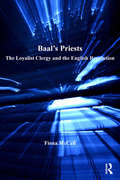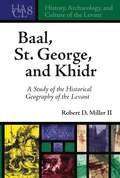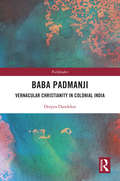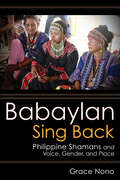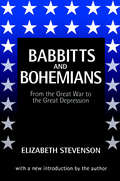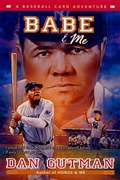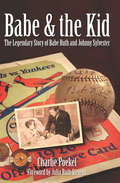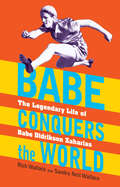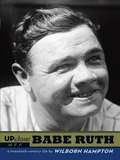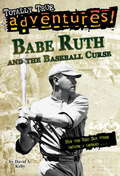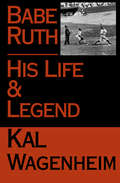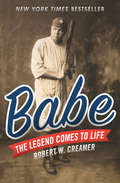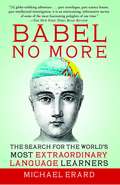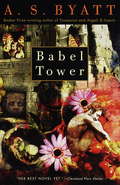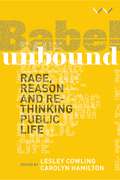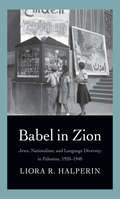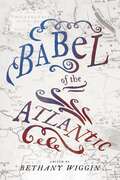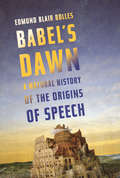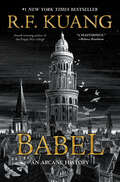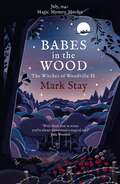- Table View
- List View
Baal's Priests: The Loyalist Clergy and the English Revolution (St Andrews Studies in Reformation History)
by Fiona McCallThe English Civil War was a time of disruption, suffering and persecution for many people, not least the clergy of the established church, who found themselves ejected from their livings in increasing numbers as Parliamentarian forces extended their control across the country. Yet, historians have tended to downplay their suffering, preferring in most cases to concentrate instead upon the persecution suffered by dissenters after the Restoration. Drawing upon an impressive array of sources - most notably the remarkable set of family and parish memories collected by John Walker in the early years of the eighteenth century - this book refocuses attention on the experiences of the sequestered loyalist clergy during the turbulent years of the 1640s and 1650s. The study highlights how the experiences of the clergy can help illuminate events in wider society, whilst at the same time acknowledging the unique situation in which Church of England ministers found themselves. For although the plundering, imprisonment and personal loss of the clergy was probably indicative of the experiences of many ordinary people on middle incomes, the ever present religious dimension to the conflict ensured particular attention was paid to those holding religious office. During the war and interregnum, zealous religious reformers attacked every aspect of established religion, targeting both existing institutions and those who supported them. Clergy were ejected on an unprecedented scale, suffering much violence and persecution and branded as 'malignants' and 'baal's priests'. By re-examining their history, the book offers a balanced assessment of the persecution, challenging many preconceptions about the ejected loyalists, and providing new insights into the experiences and legacies of this influential group.
Baal, St. George, and Khidr: A Study of the Historical Geography of the Levant (History, Archaeology, and Culture of the Levant #8)
by Robert D. Miller IIIn Western tradition, St. George is known as the dragon slayer. In the Middle East, he is called Khidr ("Green One"), and in addition to being a dragon slayer, he is also somehow the prophet Elijah. In this book, Robert D. Miller II untangles these complicated connections and reveals how, especially in his Middle Eastern guise, St. George is a reincarnation of the Canaanite storm god Baal, another "Green One" who in Ugaritic texts slays dragons.Combining art history, theology, and archeology, this multidisciplinary study demystifies the identity of St. George in his various incarnations, laying bare the processes by which these identifications merged and diverged. Miller traces the origins of this figure in Arabic and Latin texts and explores the possibility that Middle Eastern shrines to St. George lie on top of ancient shrines of the Canaanite storm god Baal. Miller examines these holy places, particularly in modern Israel and around Mount Hermon on the Syrian-Lebanese-Israeli border, and makes the convincing case that direct continuity exists from the Baal of antiquity to the St. George/Khidr of Christian lore.Convincingly argued and thoroughly researched, this study makes a unique contribution to such diverse areas as ancient Near Eastern studies, Roman history and religion, Christian hagiography and iconography, Quranic studies, and Arab folk religion.
Baal, St. George, and Khidr: A Study of the Historical Geography of the Levant (History, Archaeology, and Culture of the Levant)
by Robert D. Miller IIIn Western tradition, St. George is known as the dragon slayer. In the Middle East, he is called Khidr (“Green One”), and in addition to being a dragon slayer, he is also somehow the prophet Elijah. In this book, Robert D. Miller II untangles these complicated connections and reveals how, especially in his Middle Eastern guise, St. George is a reincarnation of the Canaanite storm god Baal, another “Green One” who in Ugaritic texts slays dragons.Combining art history, theology, and archeology, this multidisciplinary study demystifies the identity of St. George in his various incarnations, laying bare the processes by which these identifications merged and diverged. Miller traces the origins of this figure in Arabic and Latin texts and explores the possibility that Middle Eastern shrines to St. George lie on top of ancient shrines of the Canaanite storm god Baal. Miller examines these holy places, particularly in modern Israel and around Mount Hermon on the Syrian-Lebanese-Israeli border, and makes the convincing case that direct continuity exists from the Baal of antiquity to the St. George/Khidr of Christian lore.Convincingly argued and thoroughly researched, this study makes a unique contribution to such diverse areas as ancient Near Eastern studies, Roman history and religion, Christian hagiography and iconography, Quranic studies, and Arab folk religion.
Baba Padmanji: Vernacular Christianity in Colonial India (Pathfinders)
by Deepra DandekarThis book is a critical biography of Baba Padmanji (1831-1906), a firebrand native Christian missionary, ideologue, and litterateur from 19th-century Bombay Presidency. Though Padmanji was well-known, and a very influential figure among Christian converts, his contributions have received inadequate attention from the perspective of ‘social reform’ — an intellectual domain dominated by offshoots of the Brahmo Samaj movement, like the Prarthana Samaj in Bombay. This book constitutes an in-depth analysis of Padmanji’s relationships with questions of reform, education, modernity, feminism, and religion, that had wide-ranging repercussions on the intellectual horizon of 19th-century India. It presents Padmanji’s integrated writing persona and identity as a revolutionary pathfinder of his times who amalgamated and blended vernacular ideas of Christianity together with early feminism, modernity, and incipient nationalism. Drawing on a variety of primary and secondary sources, this unique book will be of great interest for area studies scholars (especially Maharashtra), and to researchers of modern India, engaged with the history of colonialism and missions, religion, global Christianity, South Asian intellectual history, and literature.
Babaylan Sing Back: Philippine Shamans and Voice, Gender, and Place
by Grace NonoBabaylan Sing Back depicts the embodied voices of Native Philippine ritual specialists popularly known as babaylan. These ritual specialists are widely believed to have perished during colonial times, or to survive on the margins in the present-day. They are either persecuted as witches and purveyors of superstition, or valorized as symbols of gender equality and anticolonial resistance. Drawing on fieldwork in the Philippines and in the Philippine diaspora, Grace Nono's deep engagement with the song and speech of a number of living ritual specialists demonstrates Native historical agency in the 500th year anniversary of the contact between the people of the Philippine Islands and the European colonizers.
Babbitts and Bohemians from the Great War to the Great Depression
by Elizabeth StevensonBabbitts and Bohemians is a fresh and informed account of the 1920s, a decade that seems almost mythical to some. Elizabeth Stevenson finds that the true twenties was a society of contrast. On the one hand, it was an era of sameness and political conformity, but on the other hand, it was also a time of cultural revolt. In places labeled Main Street and Middletown the citizenry followed a conventional pattern. At the same time, while most of America enjoyed the good life of this period, bohemians in Greenwich Village and expatriates in Paris were fervently scornful of it.The author explores the new sense of self and the world during this period, especially evident in the writings of Sinclair Lewis, Sherwood Anderson, Robert Frost, H. L. Mencken, Glenway Wescott, William Faulkner, and others. Stevenson writes about numerous facets of the 1920s: the brilliant entertainers, Harlem's brief period of glory, the worsening conditions in the South, the hero worship of Babe Ruth and Charles Lindbergh, and the stockmarket crash in 1929 that brought an abrupt end to the golden years. In the new introduction, the author reflects on her personal experience and discusses how the 1920s affected her family. She goes on to talk about how living in the tumultuous 1960s prompted her to write Babbitts and Bohemians. While she concedes that there were some not so glorious times during the 1920s, she still considers it a period where the vitality of life exhibited itself in all sorts of interesting and entertaining new ways.Elizabeth Stevenson succeeds admirably in conveying the spirit and the history of the era: the people and the mood that shaped the times; the political, international, and economic apathy; the conformity and rebellion of a decade unlike any other before or since. Babbitts and Bohemians will be enjoyed by all, especially historians, sociologists, and political scientists.
Babe & Me
by Dan GutmanOn October 1, 1932, during Game Three of the Chicago Cubs--New York Yankees World Series, Babe Ruth belted a long home run to straightaway centerfield. According to legend, just before he hit, Babe pointed to the centerfield bleachers and boldly predicted he would slam the next pitch there. Did he call that shot, or didn't he? Witnesses never agreed. Joe Stoshack knows there's one way to solve the mystery--slip back seventy years and see for himself.As fans of Dan Gutman's acclaimed novels Honus & Me and Jackie & Me know, Joe has the astonishing ability to travel through time-with baseball cards! Now he's bound for Chicago's Wrigley Field by way of Depression-era New York. Only this time his dad-who doesn't spend a lot of time with Joe in the present, never mind the past-is along for the trip. Joe has waited a long time for his father to take him to a big league game, but he never dreamed it could be this one!On October 1, 1932, during Game Three of the Chicago Cubs-New York Yankees World Series, Babe Ruth belted a long home run to straight-away centerfield.According to legend, just before he hit, Babe pointed to the centerfield bleachers and boldly predicted he would slam the next pitch there. Did he call that shot, or didn't he? Witnesses never agreed. Joe Stoshack knows there's one way to solve the mystery--slip back seventy years and see for himself.On October 1, 1932, during Game Three of the Chicago Cubs-New York Yankees World Series, Babe Ruth belted a long home run to straight-away centerfield. According to legend, just before he hit, Babe pointed to the centerfield bleachers and boldly predicted he would slam the next pitch there. Did he call that shot, or didn't he? Witnesses never agreed. Joe Stoshack knows there's one way to solve the mystery--slip back seventy years and see for himself.
Babe & the Kid: The Legendary Story of Babe Ruth and Johnny Sylvester (Sports Ser.)
by Charlie PoekelThe most famous home run in baseball history: &“The go-to book for an accurate portrayal of the story&” (Sports Collectors Digest). On the eve of game four of the 1926 World Series, Babe Ruth heard that a young New Jersey boy, Johnny Sylvester, was laid up with a deadly illness. Ruth autographed a ball for Johnny, inscribing it, &“I&’ll knock a homer for you in Wednesday&’s game—Babe Ruth.&” The rest was history. Ruth delivered on his promise, and Johnny made a miraculous recovery. In Babe & the Kid, author Charlie Poekel traces the story behind the sensational headlines, and follows Johnny&’s remarkable life in the aftermath of Ruth&’s incredible feat. Includes photos!
Babe Conquers the World: The Legendary Life of Babe Didrikson Zaharias
by Rich Wallace Sandra Neil WallaceBabe Didrikson Zaharias had one driving goal: to become the greatest athlete who ever lived. And she made good on that promise with a meteoric rise to famed basketball player, Olympic medalist, and top female golfer. But there was more to Babe than just sports. Noted novelists and sportswriters Rich and Sandra Wallace expose the many controversies surrounding this famous female athlete--her upbringing, personality, marriage, and even her early death. This action-packed story of a womanESPN ranks as #10 of the top North American athletes of the twentieth century also includes personal and professional photographs, quotes, a bibliography, and an index.
Babe Ruth
by Willborn HamptonBabe Ruth is still regarded as perhaps the greatest baseball player ever to step on a diamond. Born into a poor family in Baltimore, George Herman Ruth Jr. was sent to a Catholic reform school at age seven, where he learned how to play baseball. Initially a talented southpaw, the Babe went on to shatter every home-run record on the books?and when fewer games were played in a season and a heavier ball was used. In this engaging and fast-paced biography, award-winning author Wilborn Hampton shares with readers The Babe was also a man of big heart, temper, and appetite.
Babe Ruth and the Baseball Curse
by David A. KellyBefore 1918, the Boston Red Sox were unstoppable. They won World Series after World Series, thanks in part to their charismatic pitcher-slugger Babe Ruth. But some people on the Red Sox felt the Babe was more trouble than he was worth, and he was traded away to one of the worst teams in baseball, the New York Yankees. From then on, the Yankees became a golden team. And the Red Sox? For over 80 years, they just couldn't win another World Series. Then, in 2004, along came a scruffy, scrappy Red Sox team. Could they break Babe Ruth's curse and win it all?
Babe Ruth and the Baseball Curse (Totally True Adventures)
by Tim Jessell David A. KellyBefore 1918, the Boston Red Sox were unstoppable. They won World Series after World Series, thanks in part to their charismatic pitcher-slugger Babe Ruth. But some people on the Red Sox felt the Babe was more trouble than he was worth, and he was traded away to one of the worst teams in baseball, the New York Yankees. From then on, the Yankees became a golden team. And the Red Sox? For over 80 years, they just couldn't win another World Series. Then, in 2004, along came a scruffy, scrappy Red Sox team. Could they break Babe Ruth's curse and win it all?From the Trade Paperback edition.
Babe Ruth: His Life and Legend
by Kal WagenheimThe most famous baseball player in history, and the most enduring legend, Babe Ruth is remembered for his dramatic heroism not only on the baseball diamond but also in his life. Kal Wagenheim illustrates this larger than life athlete in his book Babe Ruth: His Life and Legends, and describes him as both a product of his childhood in Baltimore and of his formative years as a New York Yankee. Ruth struggled desperately with the dramatic contrast between the poverty of his youth and the glamour and stardom that his famed career brought him, and although his name became synonymous with wooing women and abusing alcohol, nothing could prevent him from becoming one of history&’s greatest athletes.
Babe: The Legend Comes to Life
by Robert W. CreamerThe definitive life story of the legendary Yankee slugger: &“The best biography ever written about an American sports figure&” (Sports Illustrated). Nearly a century has passed since George Herman Ruth made his major league debut, and in that time millions of words have been used to describe baseball&’s greatest hero. But for a man like the Babe, for whom the phrase &“larger than life&” seems to have been coined, those millions of words have created a mythologized legacy. Who was the real Babe Ruth? Relying on exhaustive research and interviews with teammates, family members, and friends, historian Robert W. Creamer separates fact from fiction and paints an honest and fascinating portrait of the slugger. This is the definitive biography of a man who was, in legend and in truth, the best who ever lived.
Babel No More
by Michael ErardWe all learn at least one language as children. But what does it take to learn six languages, twenty . . . seventy? Such feats of linguistic prowess provide a glimpse into what the human brain is capable of--and hold up a mirror to our desire to live without language barriers on a shrinking planet. In Babel No More, Michael Erard, "a monolingual with benefits," sets out on a quest to meet language superlearners and make sense of their mental powers. On the way he uncovers the secrets of historical figures like the nineteenth-century Italian cardinal Giuseppe Mezzofanti, who was said to speak seventy-two languages and was such a legend that when he died people all over Europe vied for his skull. Emil Krebs, a pugnacious fin de siècle German diplomat, spoke sixty-eight languages, and Erard sees the evidence of this in Krebs's dissected brain. Lomb Kató, a Hungarian hyperpolyglot who taught herself Russian by reading Russian romance novels, believed that "one learns grammar from language, not language from grammar." These massive multilinguals have long offered a natural experiment into the limits of the brain; here, at last, we can inspect the results. On his way to tracking down the one man who could be called the most linguistically talented person in the world, Erard meets other living language-superlearners. Among them is Alexander, a modern-day polyglot with dozens of languages who shows him the tricks of the trade and gives him a dark glimpse into the life of obsessive language acquisition. "I came to consider him as a holy man," writes Erard. "Others do yoga; Alexander does grammatical exercises." With his ambitious examination of what language is, where it lives in the brain, and the cultural implications of polyglots' pursuits, Erard explores the upper limits of our ability to learn and to use languages, and illuminates the intellectual potential in everyone. How do some people escape the curse of Babel--and what might the gods have demanded of them in return?
Babel No More: The Search for the World's Most Extraordinary Language Learners
by Michael ErardA "fascinating" (The Economist) dive into the world of linguistics that is "part travelogue, part science lesson, part intellectual investigation...an entertaining, informative survey of some of the most fascinating polyglots of our time" (The New York Times Book Review).In Babel No More, Michael Erard, "a monolingual with benefits," sets out on a quest to meet language superlearners and make sense of their mental powers. On the way he uncovers the secrets of historical figures like the nineteenth-century Italian cardinal Joseph Mezzofanti, who was said to speak seventy-two languages, as well as those of living language-superlearners such as Alexander Arguelles, a modern-day polyglot who knows dozens of languages and shows Erard the tricks of the trade to give him a dark glimpse into the life of obsessive language acquisition. With his ambitious examination of what language is, where it lives in the brain, and the cultural implications of polyglots' pursuits, Erard explores the upper limits of our ability to learn and use languages and illuminates the intellectual potential in everyone. How do some people escape the curse of Babel--and what might the gods have demanded of them in return?
Babel Tower
by A. S. ByattThe Booker Prize-winning author of Possession presents a stunning, contemporary story set against the clashing politics, passionate ideals, and shifting sexual roles of the early 1960s. In Byatt's vision, the presiding genius of the day seems to be a blend of the Marquis de Sade and The Hobbit. Peopled with weird and colorful characters, charted with brilliant, imaginative sympathy, Babel Tower is as comic as it is threatening and bizarre.
Babel Unbound: Rage, reason and rethinking public life
by Lesley Cowling and Carolyn HamiltonIn this timely, original and sophisticated collection, writers from the Global South demonstrate that forms of publicness are multiple, mobile and varied The notion that societies mediate issues through certain kinds of engagement is at the heart of imaginings of democracy and often centers on the ideal of the public sphere. But this imagined foundation of how we live collectively appears to have suffered a dramatic collapse across the world, with many democracies apparently unable to solve problems through talk – or even to agree on who speaks, in what ways and where. In the 10 essays in this timely, original and sophisticated collection, writers from southern Africa combine theoretical analysis with the examination of historical cases and contemporary developments to demonstrate that forms of publicness are multiple, mobile and varied. They propose new concepts and methodologies to analyse how public engagements work in society. Babel Unbound examines charged examples from the Global South, such as the centuries old Timbuktu archive, Nelson Mandela as a powerful absent presence in 1960s public life, and the challenges to the terms of contemporary debate around the student activism of #rhodesmustfall and #feesmustfall. These show how issues of public discussion span both archive and media, verbal debates in formal spaces and visual performances that circulate in unpredictable ways.
Babel in Zion
by Liora R. HalperinThe promotion and vernacularization of Hebrew, traditionally a language of Jewish liturgy and study, was a central accomplishment of the Zionist movement in Palestine in the years following World War I. Viewing twentieth-century history through the lens of language, author Liora Halperin questions the accepted scholarly narrative of a Zionist move away from multilingualism, demonstrating how Jews in Palestine remained connected linguistically by both preference and necessity to a world outside the boundaries of the pro-Hebrew community even as it promoted Hebrew and achieved that language’s dominance. The story of language encounters in Jewish Palestine is a fascinating tale of shifting power relationships, both locally and globally. Halperin’s absorbing study explores how a young national community was compelled to modify the dictates of Hebrew exclusivity as it negotiated its relationships with its Jewish population, Palestinian Arabs, the British, and others outside the margins of the national project and ultimately came to terms with the limitations of its hegemony in an interconnected world.
Babel of the Atlantic (Max Kade Research Institute)
by Bethany WigginDespite shifting trends in the study of Oceanic Atlantic history, the colonial Atlantic world as it is described by historians today continues to be a largely English-only space; even when other language communities are examined, they, too, are considered to be monolingual and discrete. Babel of the Atlantic pushes back against this monolingual fallacy by documenting multilingualism, translation, and fluid movement across linguistic borders. Focusing on Philadelphia and surrounding areas that include Germantown, Bethlehem, and the so-called Indian country to the west, this volume demonstrates the importance of viewing inhabitants not as members of isolated language communities, whether English, German, Lenape, Mohican, or others, but as creators of a vibrant zone of mixed languages and shifting politics. Organized around four themes—religion, education, race and abolitionism, and material culture and architecture—and drawing from archives such as almanacs, newspapers, and the material world, the chapters in this volume show how polyglot, tolerant, and multilingual spaces encouraged diverse peoples to coexist. Contributors examine subjects such as the multicultural Moravian communities in colonial Pennsylvania, the Charity School movement of the 1750s, and the activities of Quaker abolitionists, showing how educational and religious movements addressed and embraced cultural and linguistic variety.Drawing early American scholarship beyond the normative narrative of monolingualism, this volume will be invaluable to historians and sociolinguists whose work focuses on Pennsylvania and colonial, revolutionary, and antebellum America.In addition to the editor, the contributors include Craig Atwood, Patrick M. Erben, Cynthia G. Falk, Katherine Faull, Wolfgang Flügel, Katharine Gerbner, Maruice Jackson, Lisa Minardi, Jürgen Overhoff, and Birte Pfleger.
Babel of the Atlantic (Max Kade Research Institute: Germans Beyond Europe)
by Bethany WigginDespite shifting trends in the study of Oceanic Atlantic history, the colonial Atlantic world as it is described by historians today continues to be a largely English-only space; even when other language communities are examined, they, too, are considered to be monolingual and discrete. Babel of the Atlantic pushes back against this monolingual fallacy by documenting multilingualism, translation, and fluid movement across linguistic borders. Focusing on Philadelphia and surrounding areas that include Germantown, Bethlehem, and the so-called Indian country to the west, this volume demonstrates the importance of viewing inhabitants not as members of isolated language communities, whether English, German, Lenape, Mohican, or others, but as creators of a vibrant zone of mixed languages and shifting politics. Organized around four themes—religion, education, race and abolitionism, and material culture and architecture—and drawing from archives such as almanacs, newspapers, and the material world, the chapters in this volume show how polyglot, tolerant, and multilingual spaces encouraged diverse peoples to coexist. Contributors examine subjects such as the multicultural Moravian communities in colonial Pennsylvania, the Charity School movement of the 1750s, and the activities of Quaker abolitionists, showing how educational and religious movements addressed and embraced cultural and linguistic variety.Drawing Early American scholarship beyond the normative narrative of monolingualism, this volume will be invaluable to historians and sociolinguists whose work focuses on Pennsylvania and colonial, revolutionary, and antebellum America.In addition to the editor, the contributors include Craig Atwood, Patrick M. Erben, Cynthia G. Falk, Katherine Faull, Wolfgang Flügel, Katharine Gerbner, Maruice Jackson, Lisa Minardi, Jürgen Overhoff, and Birte Pfleger.
Babel's Dawn: A Natural History of the Origins of Speech
by Edmund Blair BollesBabel's Dawn is a saga covering six million years. Like a walk through a natural history museum, Bolles demonstrates how members of the human lineage came to speak. Beginning with a scene of the last common ancestor ignoring a bird as it flies by, he guides us through generations, illuminating how it became possible for two Homo sapiens to not only acknowledge the songbird, but to also discuss the meaning of its song. Tracing the rise of voluntary vocalizations as well as the first word, phrases, and sentences, Bolles works against the common belief that the reason apes cannot speak is they are not smart enough. In this groundbreaking work, Bolles purposes that we now have substantial evidence that this age-old idea can no longer stand. With concrete portrayals of living individuals interwoven with evidence, data, and theory, Babel's Dawn is a powerful account of a great scientific revolution
Babel: Around the World in Twenty Languages
by Gaston Dorren“Babel is an endlessly interesting book, and you don’t have to have any linguistic training to enjoy it . . . it’s just so much fun to read.” —NPREnglish is the world language, except that 80 percent of the world doesn’t speak it. Linguist Gaston Dorren calculates that to speak fluently with half of the world’s people in their mother tongues, you’d need to know no fewer than twenty languages. In Babel, he sets out to explore these top twenty world languages, which range from the familiar (French, Spanish) to the surprising (Malay, Javanese, Bengali). Whisking readers along on a delightful journey, he traces how these languages rose to greatness while others fell away, and shows how speakers today handle the foibles of their mother tongues. Whether showcasing tongue-tying phonetics, elegant but complicated writing scripts, or mind-bending quirks of grammar, Babel vividly illustrates that mother tongues are like nations: each has its own customs and beliefs that seem as self-evident to those born into it as they are surprising to outsiders. Babel reveals why modern Turks can’t read books that are a mere 75 years old, what it means in practice for Russian and English to be relatives, and how Japanese developed separate “dialects” for men and women. Dorren also shares his experiences studying Vietnamese in Hanoi, debunks ten myths about Chinese characters, and discovers the region where Swahili became the lingua franca. Witty and utterly fascinating, Babel will change how you look at and listen to the world.“Word nerds of every strain will enjoy this wildly entertaining linguistic study.” —Publishers Weekly (starred review)
Babel: Or the Necessity of Violence: An Arcane History of the Oxford Translators' Revolution
by R. F KuangInstant #1 New York Times Bestseller from the author of The Poppy War “Absolutely phenomenal. One of the most brilliant, razor-sharp books I've had the pleasure of reading that isn't just an alternative fantastical history, but an interrogative one; one that grabs colonial history and the Industrial Revolution, turns it over, and shakes it out.” -- Shannon Chakraborty, bestselling author of The City of BrassFrom award-winning author R. F. Kuang comes Babel, a thematic response to The Secret History and a tonal retort to Jonathan Strange & Mr. Norrell that grapples with student revolutions, colonial resistance, and the use of language and translation as the dominating tool of the British empire.Traduttore, traditore: An act of translation is always an act of betrayal.1828. Robin Swift, orphaned by cholera in Canton, is brought to London by the mysterious Professor Lovell. There, he trains for years in Latin, Ancient Greek, and Chinese, all in preparation for the day he’ll enroll in Oxford University’s prestigious Royal Institute of Translation—also known as Babel.Babel is the world's center for translation and, more importantly, magic. Silver working—the art of manifesting the meaning lost in translation using enchanted silver bars—has made the British unparalleled in power, as its knowledge serves the Empire’s quest for colonization.For Robin, Oxford is a utopia dedicated to the pursuit of knowledge. But knowledge obeys power, and as a Chinese boy raised in Britain, Robin realizes serving Babel means betraying his motherland. As his studies progress, Robin finds himself caught between Babel and the shadowy Hermes Society, an organization dedicated to stopping imperial expansion. When Britain pursues an unjust war with China over silver and opium, Robin must decide…Can powerful institutions be changed from within, or does revolution always require violence?
Babes in the Wood: The Witches of Woodville 2
by Mark Stay'ACE. Smart and funny and written so warmly. It's an absolutely smashing read'—Pernille Hughes, author of Probably the Best Kiss in the World ? The Witches of Woodville Part 2 July, 1940 In a quiet village in rural Kent, a magical mystery leads to murder . . . Woodville has returned to 'normal' after the departure of the Crow Folk. The villagers put out fires from aircraft shot down in the Battle of Britain, and Faye Bright discovers that magic can be just as dangerous as any weapon. The arrival of a trio of Jewish children fleeing the Nazis brings the fight for Europe to the village. When their guardian is found dead, Faye must play nanny to the terrified children while gathering clues to uncover a dark magic that threatens to change the course of the war. And she must do it quickly – the children have seen too much and someone wants them silenced for good.For fans of Lev Grossman and Terry Pratchett comes the second novel in this delightful trilogy of war, mystery and a little bit of magic . . .Praise for The Crow Folk 'Swept me straight back to days of losing myself in Diana Wynne Jones novels, and getting lost in truly absorbing, sometimes scary, sometimes emotive adventure with its roots in folklore and history. A story that is full of magic and delight that will thrill readers of any age'—Rowan Coleman, author of The Girl at the Window 'Stay has brewed a cracking blend of charm and creepiness in The Crow Folk. A rip-roaring tale of bravery and witchcraft on the wartime home front, expertly told with lashings of wit and warmth'—Pernille Hughes, author of Probably the Best Kiss in the World ? 'A delightful mash-up of Dad&’s Army and Charmed. An absolute treat'—CK McDonnell, author of Stranger Times &‘Warm, witty, witchy wartime fun. With Mark Stay as writer you're always guaranteed a magical read&’—Julie Wassmer, author of the Whitstable Pearl Mysteries &‘You'll love it: Doctor Who meets Worzel Gummidge&’—Lorna Cook, author of The Forgotten Village &‘A jolly romp with witches, demons, and bellringing. Pratchett fans will enjoy this, and Faye is a feisty and fun hero. Dad's Army meets Witches of Eastwick&’—Ian W Sainsbury
